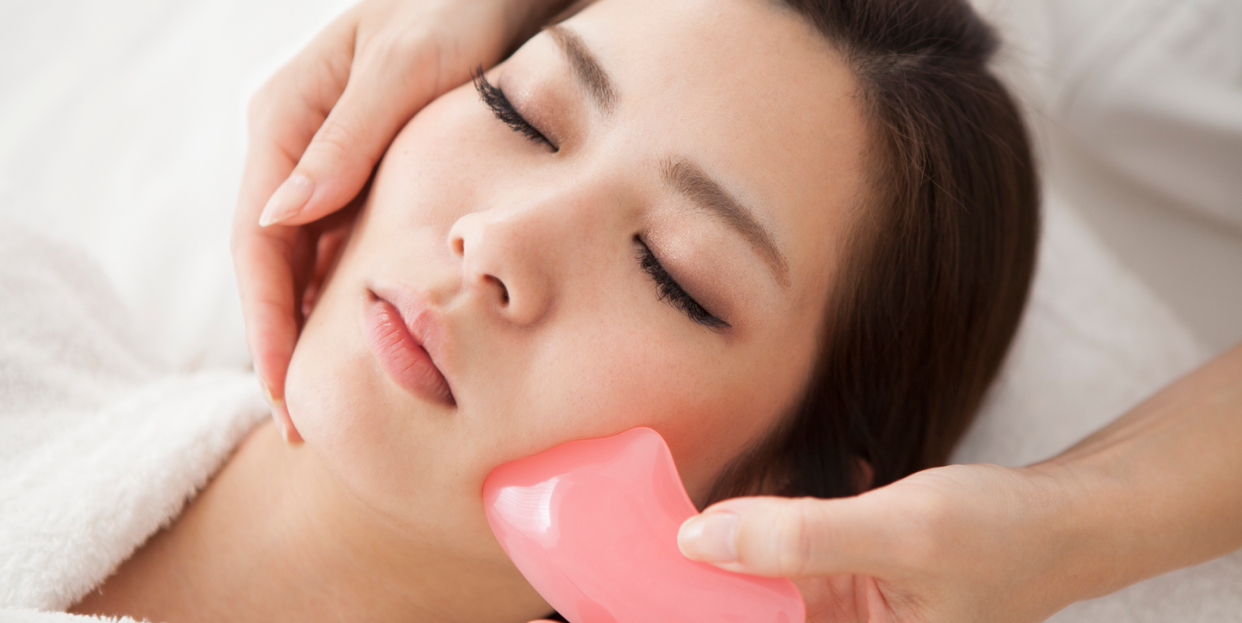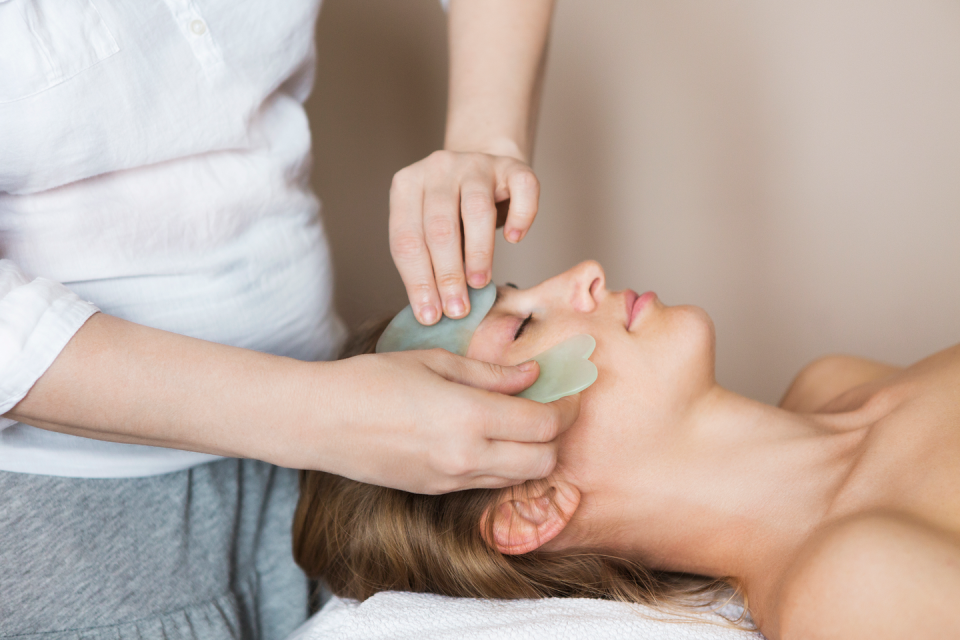How to Do a Gua Sha Facial Massage to De-Puff and Brighten Your Skin

"Hearst Magazines and Yahoo may earn commission or revenue on some items through the links below."
Your skin is one of the first things people notice about you and, with that, it’s understandable to want it to be in peak condition. One way people are attempting to ward off fine lines and wrinkles? Gua sha.
You probably know what gua sha looks like, even if you’ve never heard the word before. It’s a buzzy facial treatment that involves using flat crystals that are (gently) scraped over the skin. There are allegedly benefits of gua sha: Fans swear that this technique gives you firmer, brighter, and less puffy skin.
But is this a thing? What are the actual benefits of gua sha, if any? And—asking for a friend here—how do you do gua sha? Dermatologists break it down.
What is a gua sha facial massage, exactly?
Gua sha is an ancient Chinese practice that’s thought to promote the flow of “chi,” or energy, in the skin. The technique involves gently scraping a tool over the neck and face—usually made of jade or rose quartz and cut to fit the contours of the face—in an upward sweeping motion.
Theoretically, the pressure that’s applied to the skin via the gua sha tool causes a level of friction that improves circulation and increases blood flow to the area, says Raman Madan, M.D., board-certified dermatologist at Huntington Hospital in New York. The belief is that the uptick in blood flow can offer up plenty of skin-friendly perks, such as increased collagen production, along with reductions in puffiness, hyperpigmentation, and muscle tension.
The technique is similar to using a jade roller in that both encourage lymphatic drainage (aka reduction of accumulated fluid in your facial tissues) and decrease puffiness, but gua sha is even more effective at doing so. This is because the technique takes things a step further by acting as a facial release massage, loosening up the fibrous tissue under the skin and relaxing the facial muscles.
The gua sha tool not only gives you more flexibility in the amount of pressure you can apply, its edges contour better to the face, so you’re able to cover more ground: “The wide rolling pin shape of the jade roller can’t get into the specific areas necessary in order to allow for true drainage and de-puffing of the face,” says New York-based board-certified dermatologist Hadley King, M.D., clinical instructor of dermatology at the Weill Medical College of Cornell University.
What to keep in mind if you’re interested in gua sha
Gua sha can be intense. In fact, it usually requires pressure that’s applied “to the point of generating mild bruising of the skin to help with blood flow and skin tightness,” says dermatologist Cindy Wassef, M.D., assistant professor at the Rutgers Robert Wood Johnson Medical School.
But she issues this note of warning: “While it may feel good on the skin, there is no evidence to support that it will have any long-term effects on skin tightness or anti-aging.” Meaning, you could do this religiously and still not end up with any benefits.
Board-certified dermatologist Ife J. Rodney, M.D., founding director of Eternal Dermatology Aesthetics and professor of dermatology at Howard University and George Washington University, agrees. “Gua sha is not a replacement for seeing a dermatologist if you are interested in treating wrinkles or other skin conditions long-term,” she says. “Although most users claim this technique improves wrinkles, skin tone, and reduces acne scars, there is no medical evidence to support this.”
She also adds: “Do not expect significant changes in appearance with this technique alone.”
What are the potential skin benefits of a gua sha facial massage?

1. Relax facial tension
The friction as you glide the gua sha tool over your skin is thought to “help break up the adhesions between the connective tissue of the muscle and skin, and help relieve muscle tension,” says Philadelphia-based dermatologist Rina Allawh, M.D. If you have a tendency to hold tension in your brow or jaw when you’re stressed, the relaxing nature of gua sha may help prevent future wrinkles (along with headaches and jaw pain) from setting up shop in these areas.
2. Reduce puffiness
The lymphatic system is the body’s very own bouncer. It’s a part of your immune system, which helps distribute good nutrients and white blood cells (infection fighters) throughout the body, while also filtering out waste products like bacteria, proteins, and excess water via lymph fluid.
Because the lymphatic system doesn’t have a built-in pump the way the circulatory system does, it relies on muscle movement, respiration, and gravity to ship these fluids from one area of the body to another to be filtered. As you age, this filtration system can become compromised by things like lack of sleep, hormonal changes, high blood pressure, and skin issues like acne, eczema, and allergies, and can leave your complexion looking a tad inflated.
The sweeping directional movements of the gua sha tool, combined with the pressure used as the tool is pressed against the skin, may act as the missing pump necessary to improve lymphatic drainage, reducing puffy skin and under-eye bags in the process, says Dr. King. Be aware, though, that “the effects on puffiness are temporary,” per Dr. Wassef.
3. Improve skin’s appearance
Because improved lymph drainage and circulation means less waste products hanging around under the surface, gua sha could also translate into a clearer, brighter complexion. Plus, “stimulating the muscles with this type of technique helps bring oxygen to that area,” says Debra Jaliman, M.D., a New York City-based board-certified dermatologist and author of Skin Rules. “Anything that stimulates blood flow and oxygen to the skin can help with collagen production.” This could be helpful with minimizing fine lines and wrinkles, improving skin elasticity, and maybe reducing breakouts and hyperpigmentation.
4. Boost efficacy of skincare products
Gua sha may enhance the absorption of creams, serums, and facial oils by pressing the oil or product deeper into your skin, says Dr. Jaliman. Theoretically, by giving your circulation a boost, it may give the efficacy of your skincare products a boost too.
5. Feels good
At its core, gua sha is a massage technique, Dr. Rodney points out. “Massage can be good to help relax the muscles in the neck and face, while improving circulation,” she says. “Over time, the practice of massaging one's face as part of a nighttime skin routine might have positive effects on the look and feel of the face.”
Is gua sha safe?
Studies on body gua sha suggest the technique can considerably improve circulation, so it stands to reason that facial gua sha, although a much gentler technique, would result in similar skin benefits. “Anything that improves your circulation is beneficial to the skin,” says Dr. Jaliman. And because facial gua sha is a safe technique when done correctly, there’s no reason not to give it a whirl.
However, proceed with caution if you have active inflammation or dermatitis on the skin—or postpone entirely until your complexion clears up. “For people with cystic and pustular acne, facial gua sha may exacerbate the issue,” Dr. Allawh says. “There’s a frictional component of acne where persistent rubbing and massaging may trigger further breakouts.” Open sores and viral infections, like cold sores, are situations in which facial gua sha also shouldn’t be performed.
People with sensitive skin or clotting disorders may want to sit this technique out, says Dr. Jaliman, as gua sha can burst tiny capillaries (blood vessels) in the face.
There’s also the possibility of rosacea flare-ups if you have the skin condition and regularly do gua sha, Dr. Rodney says. “The rubbing could cause unnecessary irritation or inflammation of the skin,” she adds.
How to choose the best gua sha tool for your face

Gua sha tools are typically made out of jade, rose quartz, or mineral-rich stone, and come in a wide variety of shapes, each tailored to different areas and techniques. A broader base is usually best for the curvature of the face, such as the cheekbones, says Dr. Allawh. Small curves are generally reserved for the brow bone and eye area, the v-shape for the jaw line, and the jagged edge has been designed with the intention to target fine lines and wrinkles.
“I recommend choosing a gua sha tool that has a few options, so you can target different regions as you gain experience and expand your repertoire,” suggests Dr. King. (Herbivore Botanicals has versatile rose quartz tools, she adds.)
What’s even more important than the shape, however, is how the tool feels in your hand. If you’re not comfortable holding it, attempting to glide it over your skin might prove to be the opposite of relaxing. Once you’ve chosen your go-to gua sha tool, it’s time to get down to business.
How to do gua sha
1. Prep your base.
Start by gently cleansing and moisturizing your face and neck, then use a facial oil or serum to coat the area. “This will help the tool glide easily and prevent a ‘rug-burn’ type of injury to the skin,” says Dr. Allawh.
2. Star at your neck and work your way up.
For optimal lymphatic drainage, it’s best to start at the neck area and move upwards. Hold your gua sha tool at a 15-degree angle (it should practically be flat against the skin), and using the fingers of your free hand as traction, gently glide the tool along the skin using sweeping, upward strokes. (“If it hurts, you’re applying too much pressure,” says Dr. Jaliman. “It should feel relaxing.”) Repeat each motion three to five times for a meditative effect, suggests Dr. King.
3. Head to your chin and jaw.
Next, start from the center of your chin and sweep the gua sha tool across your jawline until you reach your ear. Repeat three to five times on each side.
4. Work the cheeks.
Starting at the crease beside your nose, sweep outwards across your cheek until you reach your ear. Repeat three to five times on each side.
5. Be gentle with your under-eyes.
Because the under-eye area is the most sensitive spot, it’s important to apply super-light pressure, gliding the gua sha tool from the inner corner of the eye to the temple. Repeat three to five times on each side, then repeat these steps in the same manner across your brow bone. Once you reach your forehead, sweep in an upwards motion from the eyebrows to the hairline. Repeat three to five times on each side.
6. Moisturize generously.
Finish off your facial massage by applying a gentle facial moisturizer. “I recommend Neutrogena Hydroboost Gel-Cream, as it contains hyaluronic acid, which promotes collagen synthesis,” says Dr. Allawh.
❗Since using unsanitary tools can cause an infection, always wash your gua sha stone after each use with warm water and a mild soap.
How often should you do a gua sha facial massage?
To start, Dr. Allawh recommends performing gua sha on your face two to three times a week to assess for any skin irritation, swelling, and discomfort after application. If you’re in the clear, feel free to make facial gua sha a relaxing daily practice. And when you’re ready to step up your gua sha game, there are plenty of tutorials to be found in Instagram and YouTube.
You Might Also Like


